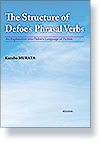検索結果一覧
The Structure of Defoe's Phrasal Verbs :An Exploration into Defoe's Language of Fiction


- 村田和穂



- A5

- 328

- 4,950円 (本体4,500円 )

- 2018年3月26日

- ISBN978-4-86327-426-6

- C3097

- 文学・語学/欧米〈文学〉

- 「イギリス小説の父」とも称されるダニエル・デフォーの小説言語を分析。デフォーの鮮烈でリアルな描写の鍵を握る「句動詞」の構造を実証的に解明する。(英文)
| 渓水社で購入する | |
|---|---|
| オンライン書店で購入 |

- Introduction
Chapter 1: The Syntactic Structure of Intransitive Phrasal Verbs
1.1 The Simple Pattern “Verb + Particle”
1.1.1 Fronting of the Particle
1.2 Adverbial Insertion: the “Verb + Adverbial + Particle” Pattern
1.3 The Composite Pattern “Verb + -ing (Present Participle) + Particle”
1.4 Towards a “Phrasal-prepositional Verb”: the Structure of “Verb + Particle + Preposition”
1.4.1 The Use of Upon in Defoe’s fiction
1.4.2 Idioms or Set Phrases
1.4.3 Hybrid Formation
1.5 Gerunds
1.5.1 Groups with a Determiner
1.5.2 Groups Lacking a Determiner
1.6 Conversion of Intransitive Phrasal Verbs into Nouns (or Adjectives)
Chapter 2: The Syntactic Structure of Transitive Phrasal Verbs
2.1 The Pattern “Verb + Particle + Object”(VPO)
2.1.1 The Simple Pattern
2.1.2 Phrasal Verbs as a Reporting Verb
2.2 The Pattern “Verb + Object + Particle”(VOP)
2.2.1 The Pattern “Verb + Personal Pronoun + Particle”
2.2.2 The Pattern of “Verb + Reflexive Pronoun + Particle”
2.2.3 The Pattern “Verb + Non-personal Pronouns + Particle”
2.2.4 The Division of Object by the Particle: As Special Cases of the VOP Pattern
2.3 The Fronting of the Particle: the Pattern “Particle (+ Subject) + Verb + Object”(PVO)
2.4 The Pattern “Object (+ Subject or To) + Verb + Particle”(OVP)
2.4.1 The OVP in the Main Clause
2.4.2 The OVP in the Subordinate Relative Clause
2.4.3 The OVP in the To-Infinitive Construction
2.5 The Pattern of “Verb + (Indirect) Object + Particle + (Direct) Object”(VOPO)
2.5.1 The VOPO Pattern
2.5.2 Additional Patterns: VOOP, VPOO and OVOP
2.6 Passive Construction
2.6.1 With Be-Verbs
2.6.2 The Passive Progressive
2.6.3 Without Be-Verbs
2.6.4 Adjectival Use
2.7 Gerunds
2.7.1 The VPO Pattern
2.7.2 The VOP Pattern
2.7.3 The OVP Pattern
2.7.4 Passive Construction
2.7.5 The Pattern Distribution in the Gerund Construction: Statistical Summary
2.8 Adverbial Insertion: the “VP [adv] O” and “VO [adv] P” Patterns
2.8.1 The “VP [adv] O” Pattern
2.8.2 The “VO [adv] P” Pattern and the “V [adv] P” Pattern
2.9 The Composite Pattern of “V and VPO” or “V and VOP”
2.10 Distribution of Syntactic Patterns in Transitive Phrasal Verbs
2.10.1 Choice between VPO and VOP
Chapter 3: Semantic and Stylistic Analysis of Phrasal Verbs: Six Aspects
3.1 Coordinated Use with Other Verbs: the “A and B (and C . . .)” Pattern
3.1.1 Cohesive Relation in the “A and B” Coordination
3.1.2 Synonymous Relation in the “A and B” Coordination
3.1.3 Coordinated with Words or Phrases of Different Word Class
3.2 Inversion and Particle Fronting for Stylistic Effect
3.3 The Function of Particles in Psychological Contexts
3.3.1 The Function of Particles in Intransitive Phrasal Verbs
3.3.2 The Function of Particles in Transitive Phrasal Verbs
3.3.3 Orientational Metaphors: Down and Up
3.4 Descriptions of the Sea: With Special Reference to Nautical Terms
3.4.1 Descriptions of Navigation
3.4.2 Descriptions of Scenery
3.4.3 The Role of Absolute Participial Construction
3.5 The “Redundant” Use of Particles
3.6 Repetition and Synonym: the Case of Shut Up
3.6.1 Repetition of Shut Up
3.6.2 Synonyms for Shut Up
Conclusion
References
Appendix



